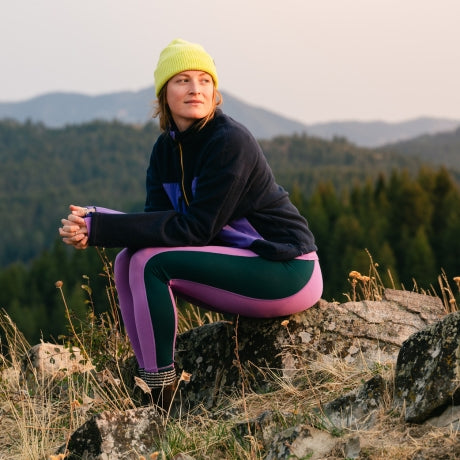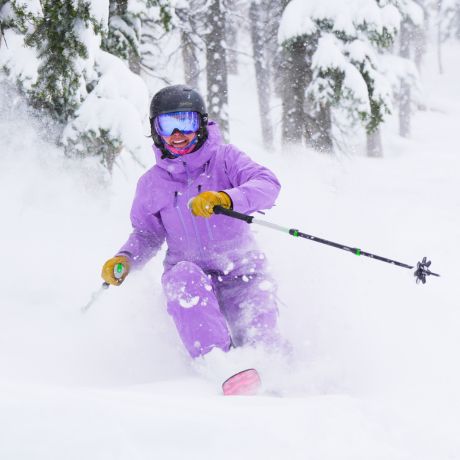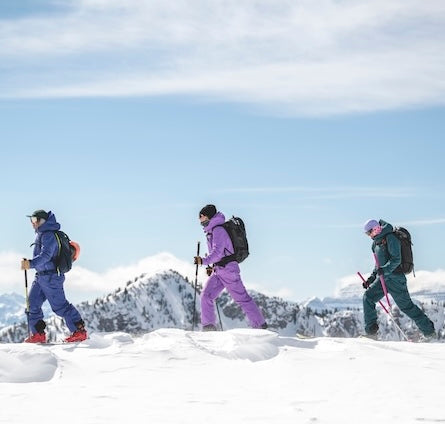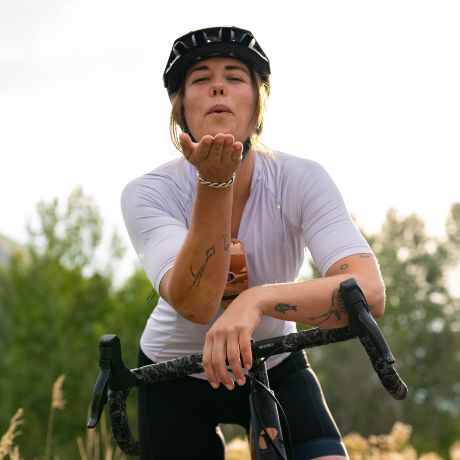
One is Not Enough.

Photo by Katie Lozancich
Spoiler alert: you’re going to have goosebumps watching Nexus. It’s raw and real in ways that feel big and genuine. Sure, it has all of the makings of a top-notch (and funny) ski film. There are dance parties, fake mustaches, potentially every Skida print in existence, and puckering lines. But, more than that, it talks about many of the things we often ignore in skiing. It talks about fear. It talks about belonging. About aging. About finding your voice.
Nexus is an ode to the process. A middle finger to the notion that there can only be one token girl or that progress has to look a certain way. Or that skiing has to look a certain way.
It speaks to the importance of mentorship and growth through challenge and failure (and the importance of zipping all of your pockets while skiing).
While it’s not the first female ski film (Pretty Faces, The Blondes, The Approach Film, and many other short films have made leaps and bounds for on-screen female exposure over the past few years), it is the first feature-length film featuring all female skiers that was entirely directed, produced, and edited by an all female team. Shot in Revelstoke, Grand Teton National Park, the Cascades, and Alaska, Nexus tells the story of five skiers by way of their stories, their careers, and their aspirations.
We had the opportunity to talk with producers Shannon Corsi and Katie Lozancich to learn a little bit more about the making of Nexus.

Tell us about the inspiration to bring Nexus to life?
Shannon: I got into snow sports when I was 21. I moved to Big Sky, Montana more or less on a whim, and learned to snowboard. I ended up staying there for 4 years before moving to the Tetons. During that time, I really found my place in skiing by having some incredible friendships with other women. I’m still very close friends with that crew, we still manage to ski at least a few days together every year, despite living in different places. I started consuming ski media around that time as well, and it was really shocking how women were represented. I would go to premieres with friends and we would see the same thing over and over again: one woman on screen surrounded by men, most of the time their narratives were boiled down to “I’m a woman in skiing.” It felt like such a disservice, these athletes were best of the best, they had to have cooler stories to tell. After quite a few years of this, it was more or less like “well someone has gotta do it” and started the process of creating Nexus. Were we qualified? Not really, all together we rounded out to like one experienced producer. Sophie and I had a decade of experience in the media industry - I worked in commercial photography and production, she worked as a cinematographer and editor. Katie had worked for TGR for 5 years, and was pretty up and close with what film sets were like. None of us had directed or produced a film, and we had no proof of concept, which made pitching hard.
What did the process look like once you had decided to make this idea a reality?
Shannon: There’s so much that goes into making a project like this, but to give a super broad overview:
DIY’ing a high quality feature film can basically be broken down into 6 stages:
Concept: creating a storyline, reaching out to athletes, fine tuning your concept and preparing pitch materials.
Pitching: Trying to get sponsorships, laughing off the funny harsh rejections that we sometimes got.
Production: Running logistics, hiring filmers, actually filming.
Post-production: Deliverables, editing, feedback, basically making the film come to life.
PR/Marketing: Press pitch-outs, interviews, social management, calendars, sponsor promotions, etc.
Distribution: Tour and digital release

What was your experience like trying to raise money and get sponsors involved?
Shannon: It was quite a bit of work, and at the time I was grateful that I was used to pitching and was relatively unfazed by getting a lot of “no”s. At the beginning, we really got some rejections that were honestly funny in how brutal they were. We had someone verbatim say “no offense, but we have standards” and even at the time, I remember getting on a call with Sophie and laughing about it. After Redbull signed on, we saw a lot less push-back, and a lot more people being genuinely interested in the project. At the end of the day, we found the right sponsors who were really excited about the film and what we were doing. We’ve used some of the harsher feedback for social content because people love it, but honestly every rejection was just an indicator that things weren’t a good fit. It’s not personal. Process wise, so much of pitching is finding warm introductions, and we really lucked out having Cassie Abel, Corinne Prevot and Michelle Parker help out for this part of the process. They all wrote a huge number of introductions to essentially vouch for us.
Tell us about your shoot locations? How did those come to be?
Katie: We filmed in Alaska, Washington, Wyoming, and Revelstoke. The locations were a byproduct of our strong collaboration with our athletes. We wanted them to be excited about where they were skiing and film in a location that added depth to their story. For example, Brooklyn and Michelle's story explored the idea of progression and mentorship, and Alaska seemed like the perfect backdrop to explore those themes further. We also wanted to vary the locations so visually they'd add some variety to the overall film. For example, it was fun to play with urban textures in Seattle, Washington, for Krystin and Sasha's segment, and classic mountain town vibes for Caite and Veronica's
What was a highlight of working on NEXUS?
Katie: Is it okay if I write a novel? But picking one singular moment from the Nexus filmmaking experience is challenging because there were so many beautiful moments! Out of everything, I loved the shared collaboration from everyone involved: the athletes, the filmmakers, our guides, and even the brands who supported us. In addition, there was this strong camaraderie because we all wanted to shake things up in the industry. It's been incredible to see how folks have shown up for us and shows how needed this project was.
And personally, going to Alaska was surreal. It's like going to the Grammys or the Oscars as an action sports photographer because it's such a big accomplishment. There was this moment where I got dropped off on this knife-edge ridge to shoot a long lease angle of Michelle and Brooklyn skiing spines. I remember looking around the Chugach Mountains thinking, "if only I could show my 19-year-old self what I'd someday be doing."

Photo by Katie Lozancich
What is it like being part of an all-women ski film versus being one of the token gals?
Katie: In most of the films I'd worked on before this, I had been the token gal on an all-male production team. It was a change of pace being on a primarily all-women crew, and it wasn't necessarily better or worse—the past men I've worked with are some of my closest colleagues—but for once, I saw myself reflected in my peers. That pushed me in ways I could have never imagined! I constantly thought, "If Sophie can keep up with the athletes with a heavy camera pack, then I can do that one day too," or "If Shannon can eloquently direct a shoot, I can do that too." For once, I had role models I didn't even know that I needed.
How did you get your start in the outdoor industry? Was there a particular moment that you decided you wanted to make in ski films?
Katie: I accidentally stumbled into the outdoor industry and learned to ski when I was 19. In college, I was studying photography and couldn't figure out what kind of photographer I wanted to be. I found my answer at my first-ever Warren Miller movie premiere. I don't remember anything about the film except realizing that people got paid to make ski films and take photos in all these wild places. I dropped out of college shortly after and moved up to Tahoe to make that dream a reality….pretty fantastic to think that it came to fruition nearly a decade later.
Shannon: My career path has really been all over the place. I was getting paid to shoot photos when I was 16, and shot weddings and portraits exclusively for 5 years. I was quite successful at that, but it wasn’t really something I wanted to do long term. After that, I ended up moving to Big Sky to take a break, and didn’t shoot during the winters where I lived there. During the summers, I continued to take a variety of photoshoots. One summer, I moved out to Connecticut to teach a photography course at Yale. I had just spent a few weeks living in the forest at Mt. Hood, really living the dirtbag lifestyle, so it was a hilarious transition to walk into that environment right after. After I left Big Sky, I made a more official transition to the commercial world and went back to shooting full time. I had done a number of commercial photoshoots, and really loved that. Shooting skiing is a blast, so I knew I wanted to do more of that.

Photo by Katie Lozancich
Are there plans in the works for another all-ladies outdoors film?
Shannon: We get a lot of questions about a sequel! There’s no plans for a sequel, and honestly opting to not go for a sequel is intentional for me. I’d rather clear the path for similar small crews with a big dream to tell stories that haven’t been told; I hope our sponsors felt Nexus was a good investment and are open to putting money behind similar projects in the future. I’m sure you’ll see all of our names on film projects in the future, we’re all planning on staying in the industry. We’ll all go in different exciting directions after this, and I’m excited to see what Katie and Sophie get up to next!
Where did the name Nexus come from?
Katie: The word Nexus means "a connection or series of connections linking two or more things". We drew inspiration from that idea in two major ways. First, there's a nexus between us and the mountains, and we believe that this is a space that fosters growth, companionship, and adventure. Throughout the film, we've presented five pairs of friendships, and we explore how those relationships have impacted their lives, and what it means to have deep, meaningful relationships in the mountains. We wanted to explore stories that were all distinct and captured the range of experiences these women had in the mountains. The thing tying it all together? Skiing.

Photo by Shannon Corsi
As the ski industry grows and changes, there is an increased ask for equal representation across the board. For years, we have seen (conventionally attractive) cis white men huck themselves off massive cliffs and jumps, crack beers and jokes on tailgates, and make life-or-death decisions at the top of impossibly steep lines. To watch a group of gals do these same things – as part of an entirely female crew – truly feels like a moment that should be acknowledged, celebrated, and recognized as just the beginning of this new era of skiing.
CHECK OUT THE FULL NEXUS TOUR LINE-UP
Sun Valley Premiere, Hosted by Wild Rye - October 19: BUY TICKETS!
written by: Ren Egnew


![[Iced Matcha] Iced Matcha Keller Crop Tank in a flatlay view](http://wild-rye.com/cdn/shop/files/WILDRYE-KELLERCROPMATCHALEAD_R1_1.jpg?v=1741123409&width=1024)
![[Iced Matcha] Keller Crop Tank iced matcha front crop](http://wild-rye.com/cdn/shop/files/1_c28d0b8e-0fd7-4037-bd98-1b989466e5db.jpg?v=1741123409&width=1024)
![[Matcha Morchella] Eleanor Chammy Matcha Morchella flatlay](http://wild-rye.com/cdn/shop/files/WILDRYE-ELANORMATCHALEAD_R1.jpg?v=1749682242&width=1024)
![[Matcha Morchella] Eleanor Chammy Matcha Morchella side pocket detail](http://wild-rye.com/cdn/shop/files/WILDRYE-_10326_1.jpg?v=1749682242&width=1024)
![[Olive You] Eeva short overalls olive green in layflat view](http://wild-rye.com/cdn/shop/files/WILDRYE-EEVAOVERALLSPRUCELEAD_R1.jpg?v=1740700436&width=1024)
![[Olive You] Eeva short overalls olive green front full body](http://wild-rye.com/cdn/shop/files/WILDRYE-_10963.jpg?v=1740700436&width=1024)
![[Matcha Morchella] Matcha Morchella print Rita 6" bike short layflat](http://wild-rye.com/cdn/shop/files/WILDRYE-RITAMATCHALEAD_R1.jpg?v=1754605456&width=1024)
![[Matcha Morchella] Matcha Morchella print Rita 6" bike short full body](http://wild-rye.com/cdn/shop/files/WILDRYE-_11769.jpg?v=1754605456&width=1024)
![[Iced Matcha] Wild Rye Mackay Crop Tee Iced Matcha Flatlay](http://wild-rye.com/cdn/shop/files/WILDRYE-MACKAYMATCHALEAD_R1_1.jpg?v=1756849469&width=1024)
![[Iced Matcha] Wild Rye Mackay Crop Tee Iced Matcha Front Crop](http://wild-rye.com/cdn/shop/files/WILDRYE-_10344.jpg?v=1756849469&width=1024)
![[Black] Freel Bike Short Black Flatlay](http://wild-rye.com/cdn/shop/files/WILDRYE-FREELBLACKLEAD_R1.jpg?v=1757971505&width=1024)
![[Black] Freel 12" bike shorts in black, on model front crop view](http://wild-rye.com/cdn/shop/files/WILDRYE2984.jpg?v=1757971648&width=2048)
![[Black] Parker Skort Black Flatlay](http://wild-rye.com/cdn/shop/files/WILDRYE-PARKERSKORTBlackLEAD_R1.jpg?v=1751564534&width=1024)
![[Black] Parker Skort Black front full body, paired with green tank top](http://wild-rye.com/cdn/shop/files/WILDRYE4806.jpg?v=1757605449&width=2048)
![[Sedona Vista] Bike water bottle with sedona vista print](http://wild-rye.com/cdn/shop/files/WILDRYE-WATERBOTTLESEDONA_R1.png?v=1741137070&width=1024)
![[Watercolor] Bike water bottle with watercolor print](http://wild-rye.com/cdn/shop/files/WILDRYE-WATERBOTTLEWATERCOLOR_R1.png?v=1741137070&width=1024)






Leave a comment
This site is protected by hCaptcha and the hCaptcha Privacy Policy and Terms of Service apply.